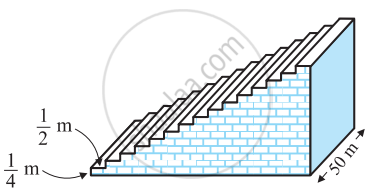Advertisements
Advertisements
Question
Find whether 55 is a term of the A.P. 7, 10, 13,... or not. If yes, find which term is it.
Solution
Yes.
Let the first term, common difference and the number of terms of an AP are a, d and n respectively.
Let the nth term of an AP be 55
i.e., Tn = 55
We know that,
The nth term of an AP,
Tn = a + (n – 1)d ...(i)
Given that,
First term (a) = 7
and common difference (d) = 10 – 7 = 3
From equation (i),
55 = 7 + (n – 1) × 3
⇒ 55 = 7 + 3n – 3
⇒ 55 = 4 + 3n
⇒ 3n = 51
∴ n = 17
Since, n is a positive integer.
So, 55 is a term of the AP.
Since, n = 17
Therefore, 17th term of an AP is 55.
RELATED QUESTIONS
The houses in a row numbered consecutively from 1 to 49. Show that there exists a value of x such that sum of numbers of houses preceding the house numbered x is equal to sum of the numbers of houses following x.
The sum of the third and the seventh terms of an AP is 6 and their product is 8. Find the sum of first sixteen terms of the AP.
A small terrace at a football field comprises 15 steps, each of which is 50 m long and built of solid concrete. Each step has a rise of `1/4` m and a tread of `1/2` m (See figure). Calculate the total volume of concrete required to build the terrace.
[Hint: Volume of concrete required to build the first step = `1/4 xx 1/2 xx 50 m^3`]

Find the sum 2 + 4 + 6 ... + 200
The sum of three numbers in AP is 3 and their product is -35. Find the numbers.
Write an A.P. whose first term is a and common difference is d in the following.
If the 9th term of an A.P. is zero then show that the 29th term is twice the 19th term?
If m times the mth term of an A.P. is eqaul to n times nth term then show that the (m + n)th term of the A.P. is zero.
Rs 1000 is invested at 10 percent simple interest. Check at the end of every year if the total interest amount is in A.P. If this is an A.P. then find interest amount after 20 years. For this complete the following activity.
What is the sum of first 10 terms of the A. P. 15,10,5,........?
Write the common difference of an A.P. whose nth term is an = 3n + 7.
For what value of p are 2p + 1, 13, 5p − 3 are three consecutive terms of an A.P.?
If the sum of P terms of an A.P. is q and the sum of q terms is p, then the sum of p + q terms will be
If the sums of n terms of two arithmetic progressions are in the ratio \[\frac{3n + 5}{5n - 7}\] , then their nth terms are in the ratio
The sum of the first 15 multiples of 8 is ______.
The sum of first ten natural number is ______.
The sum of all two digit odd numbers is ______.
Find the sum of last ten terms of the AP: 8, 10, 12,.., 126.
Find the sum of all odd numbers between 351 and 373.
If the first term of an A.P. is p, second term is q and last term is r, then show that sum of all terms is `(q + r - 2p) xx ((p + r))/(2(q - p))`.
